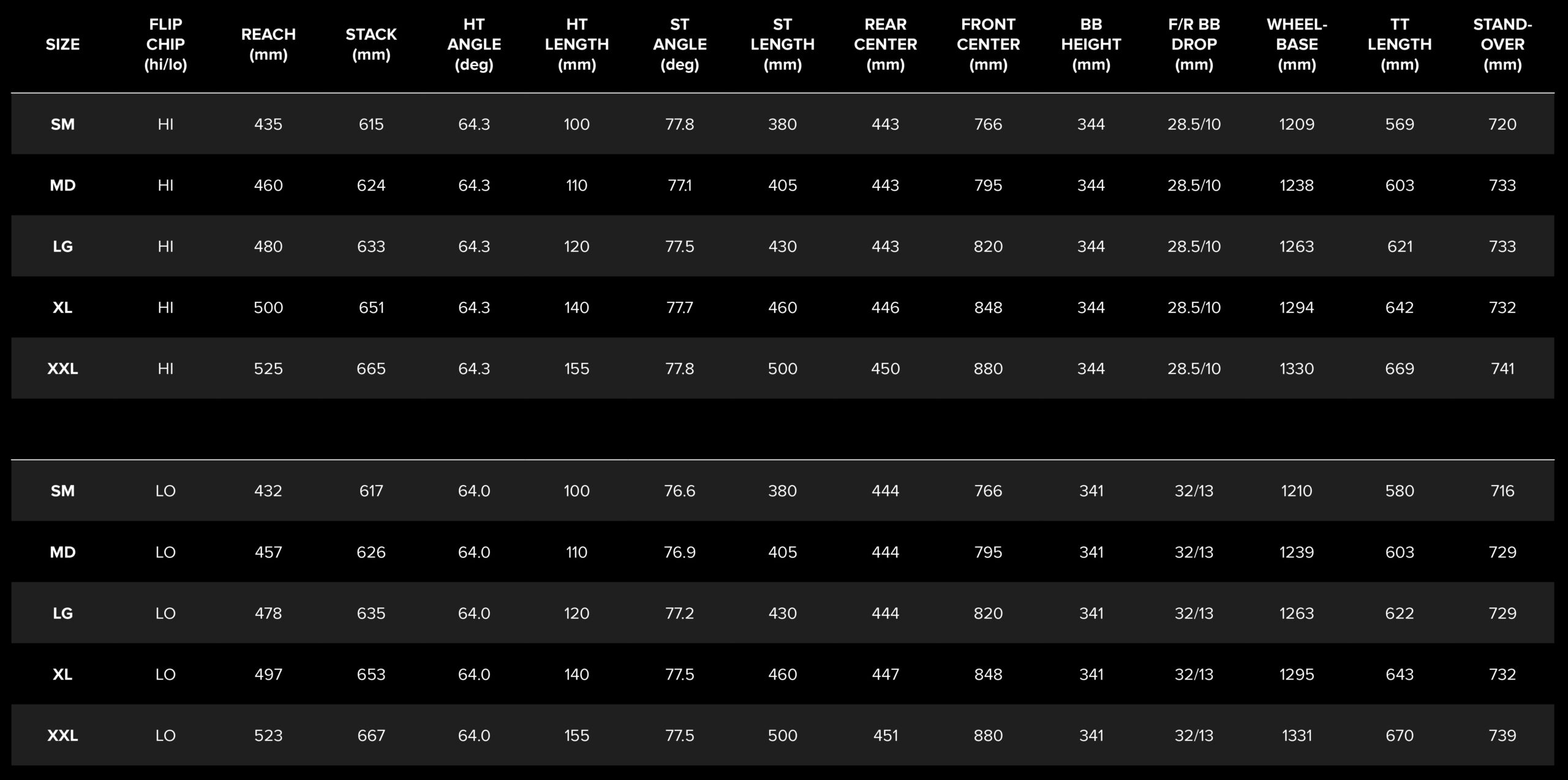Santa Cruz Heckler SL
Wheel Size: 27.5’’ rear / 29’’ front
Travel: 150 mm rear / 160 mm Front
Geometry Highlights:
- Sizes offered: S, M, L, XL, XXL
- Headtube angle: 64.0° (Low) / 64.3° (High)
- Seat tube angle (size L): 77.2° (Low) / 77.5° (High)
- Reach (size L): 478 mm (Low) / 480 mm (High)
- Chainstay length (size L): 444 mm (Low) / 443 mm (High)
Drive System Highlights:
- Motor: Fazua Ride 60
- Torque: 60 Nm
- Battery: 430 Wh
- Display: Fazua integrated top tube display
- Remote: Fazua Ring Controller
Material: Carbon Fiber
Price: Complete bikes $7,299 to $12,999
Blister’s Measured Weight (Size Large, GX AXS build): 42.6 lb / 19.3 kg
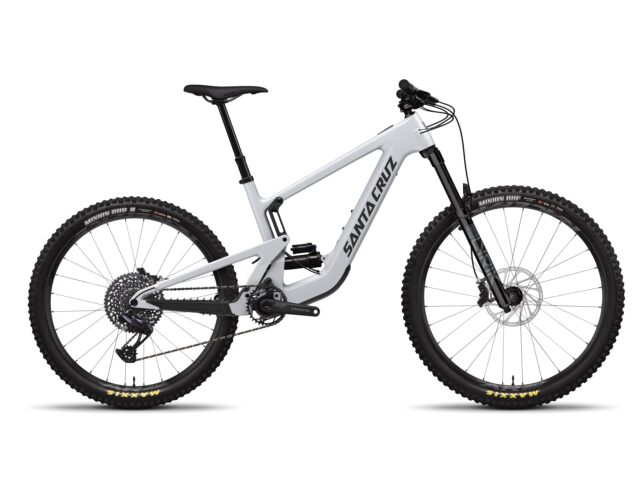
Intro
There’s no doubt that the lightweight eMTB segment is growing right now, with bikes seemingly dropping left and right. Santa Cruz’s new Heckler SL brings a lot of the tweaks you’d expect for the genre — chiefly a compact drive system from Fazua and a smaller battery — but it’s not just the standard Heckler on a diet. The Heckler SL gets some geometry tweaks as compared to the standard version, is offered with mixed wheel sizes only, and a bunch of other little updates.
The Frame
The Heckler SL frame follows the same design language we’ve come to expect from Santa Cruz, with their lower-link-driven VPP suspension layout, and save for the beefier downtube, it’s almost indistinguishable from their non-motorized bikes. With 150 mm of rear wheel travel, it has the same travel as the existing full-power Heckler and also the non-motorized Bronson. The Heckler SL is also a dedicated mixed-wheel-size bike, unlike the full-power Heckler, which is offered in both MX and full 29” versions. The Heckler SL frame is available in either “Carbon C” or “Carbon CC” versions, with the higher-end CC getting a fancier layup that’s slightly lighter. As to be expected, there is no in-frame storage since the battery takes up that space, but there is still room for one water bottle inside the main triangle.
There is a flip chip that changes the bottom bracket between “low” and “high” settings, which of course also results in other geometry changes — more on that below. Santa Cruz hasn’t supplied any suspension kinematic data for the Heckler SL, but their flip chips usually make their bikes a touch more progressive in the low setting, and given the similarities in layout, we’d bet on the same being true here.
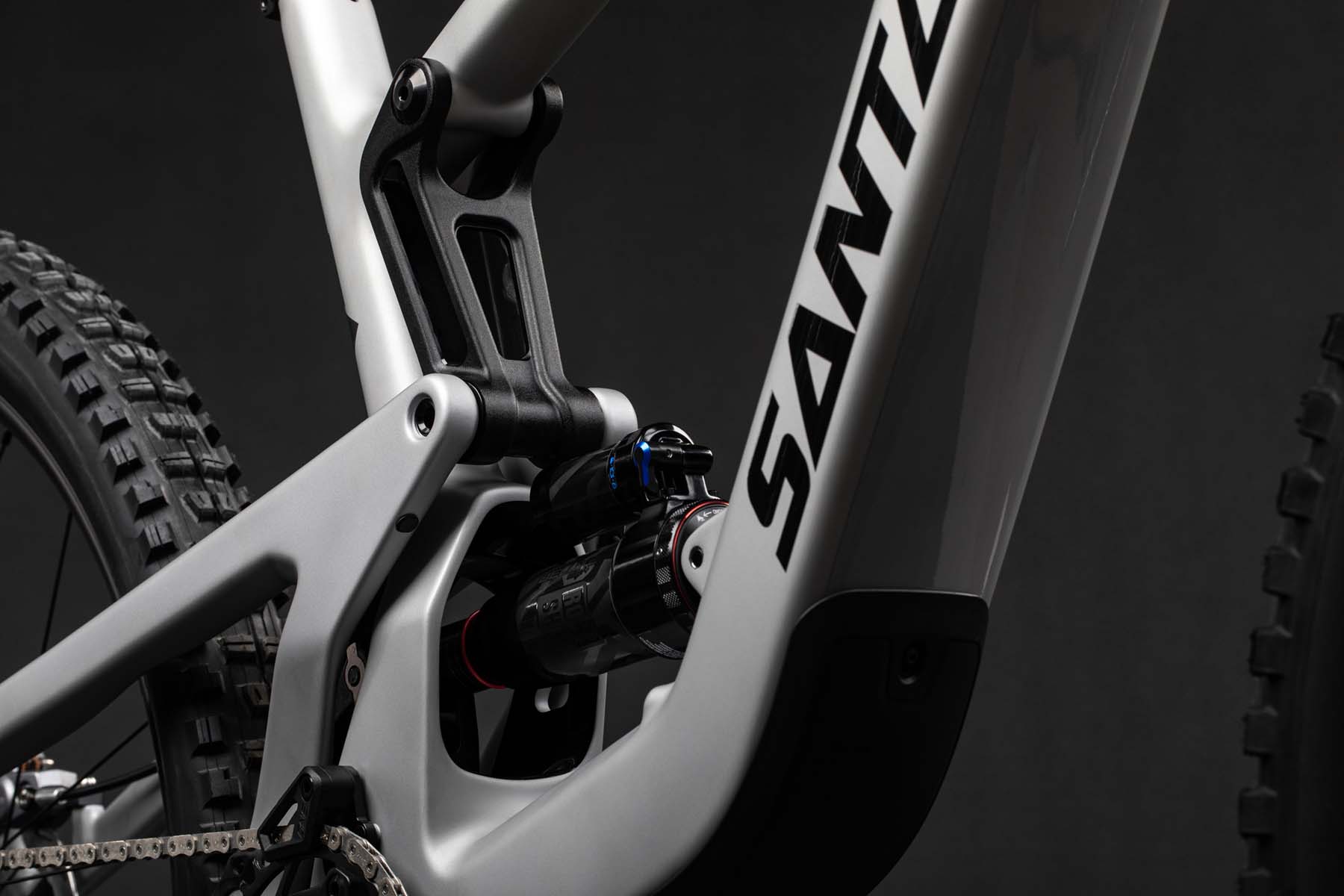

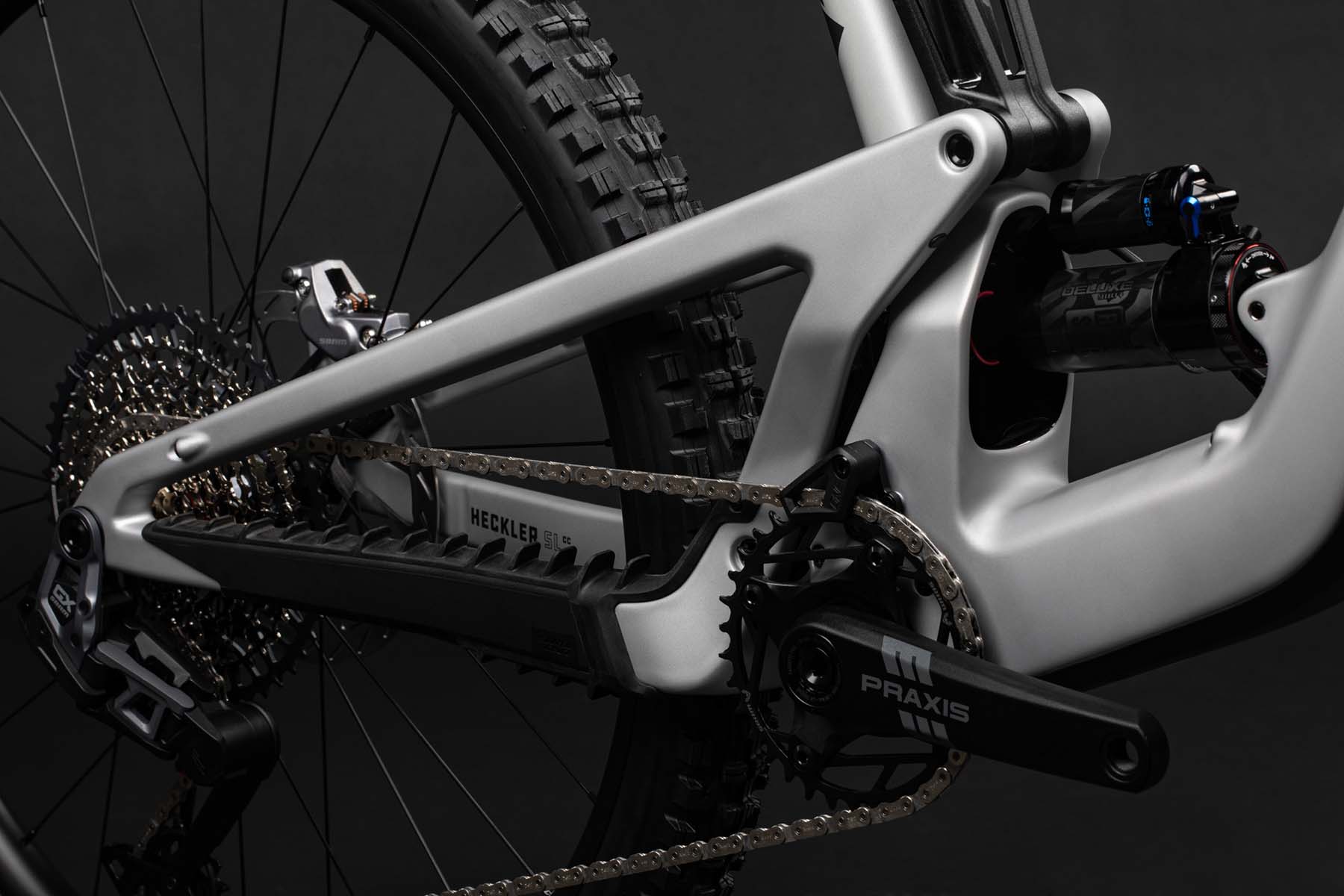
Drive System
Santa Cruz has partnered with Fazua to supply the drive system for the Heckler SL. Not unlike the full-power eMTB scene, there are only a couple of options when considering lightweight, compact drive systems — Fazua and TQ seem to own the majority of the market, but we expect to soon see more bike brands spec’ing Bosch’s recently-launched lightweight Performance Line SX motor.
Based in Germany, Fazua has been a pioneer in lightweight eMTB drive systems since its founding in 2013. Also of note, they were acquired by Porsche in June of 2022, so now you can get away with saying your eMTB has a Porsche motor.
The Heckler SL’s compact motor delivers a stated 60 Nm of peak torque and incorporates a boost function that can deliver up to a claimed 450 Watts in short bursts. Fazua states a total system weight of 4.2 Kg (9.3 lb), including the battery. For reference, a Bosch Performance Line CX motor (85 Nm of torque) and 625 Wh battery weighs approximately 14.5 lb (not including the display).
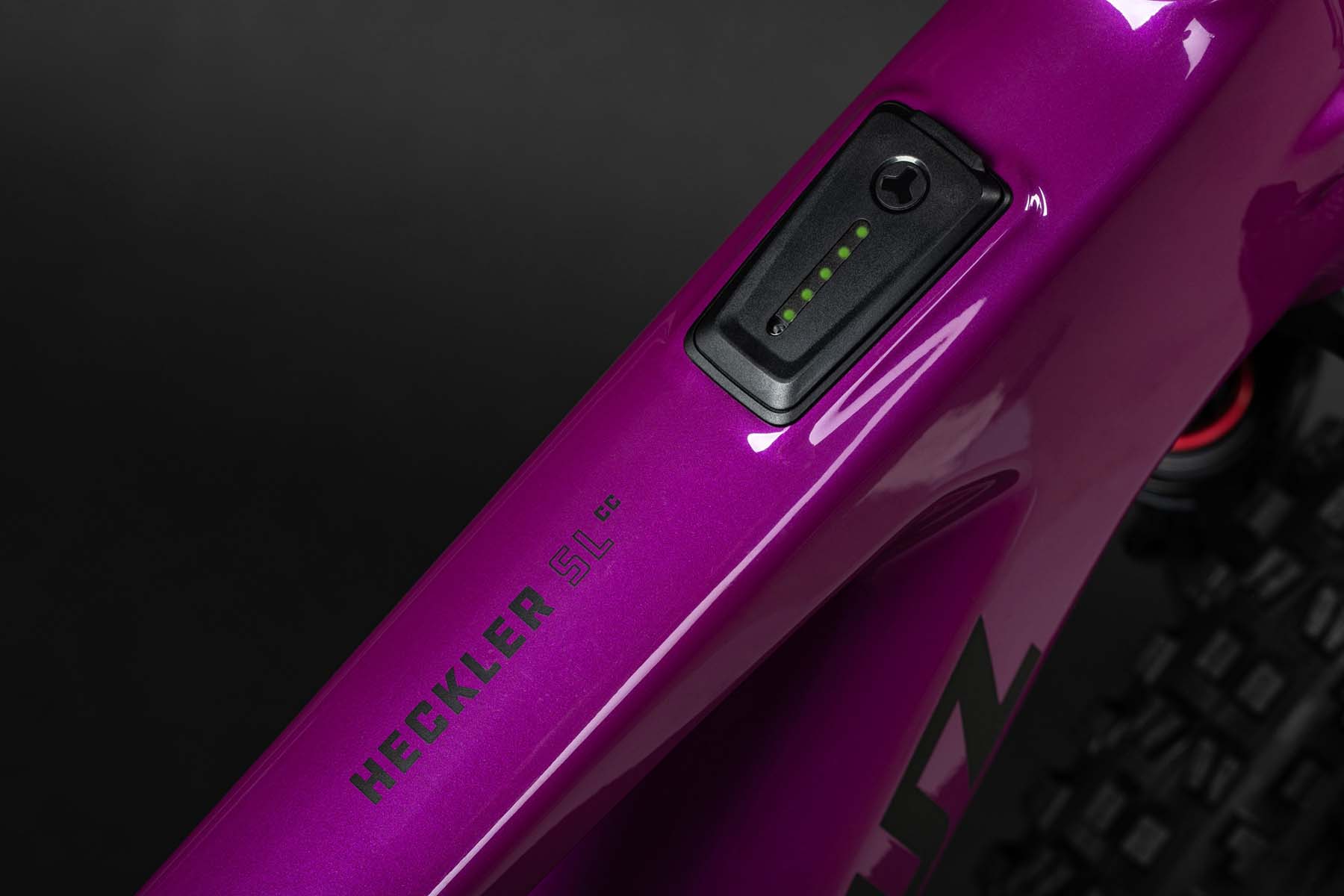
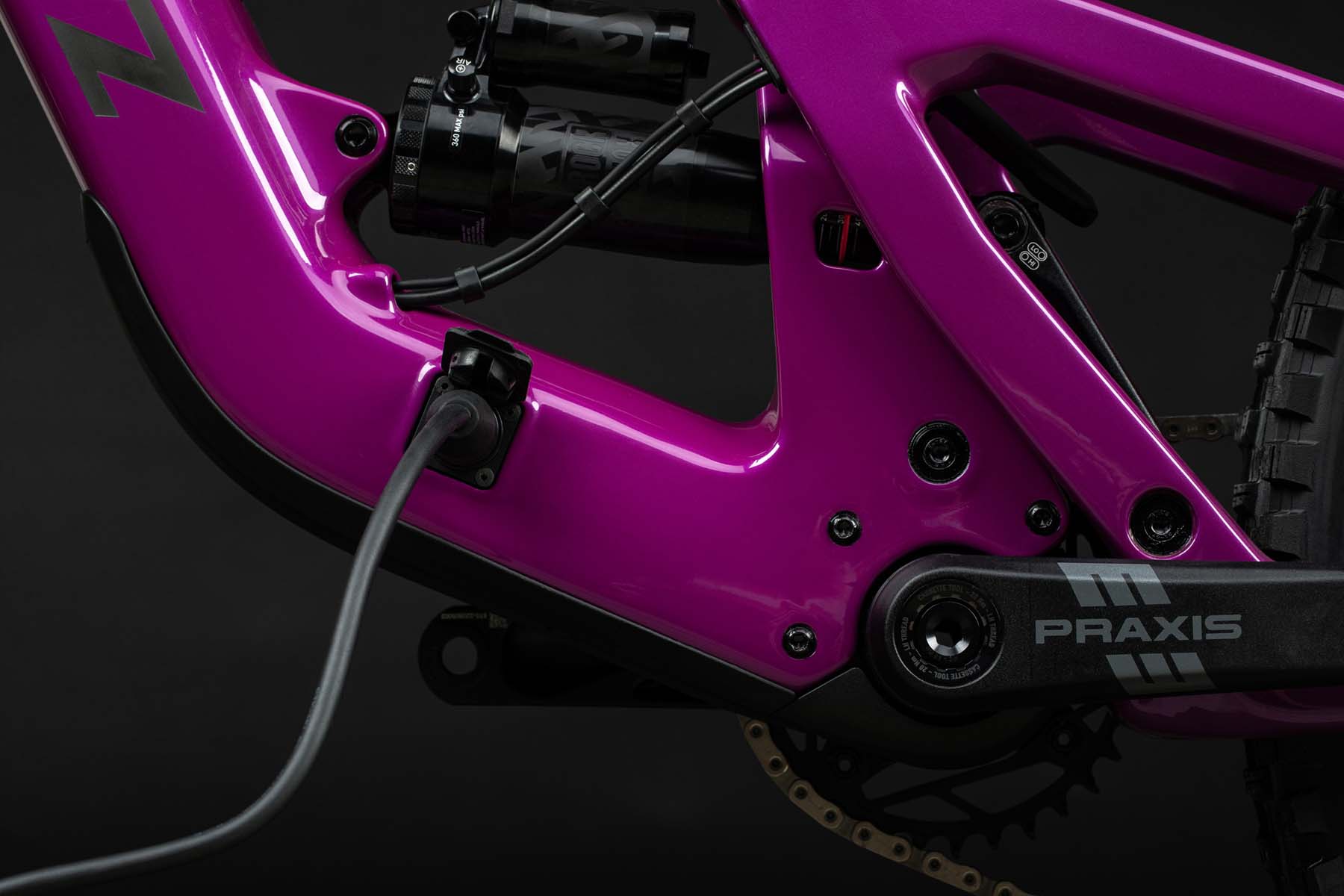
Fit & Geometry
The Heckler SL is available in five sizes — Small through XXL. The XL and XXL are the only sizes that have size-specific chainstays; the Small, Medium, and Large frames share the same 444 mm stays (low setting), with those numbers growing to 447 mm and 451 mm on the XL and XXL, respectively. The new Heckler SL also has a slacker head angle than both the Bronson and standard Heckler, at 64º in the low setting — matching Santa Cruz’s longer-travel, full-power Bullit.
With a 77.2º / 77.5º seat tube angle (size Large), the Heckler SL has one of the steeper seat tube angles in Santa Cruz’s lineup, and is steeper than both the Heckler and Bullit, with only the Nomad and Megatower coming in steeper. As mentioned above, there is a flip chip that changes geometry between high and low bottom bracket settings, which of course affects the other geometry numbers as well. The reach, for example, grows from 478 mm in the low setting to 480 mm in the high one. The changes afforded by the flip chip aren’t massive, but it is nice to be able to dial things in just a little bit to suit personal preferences, or to tune for certain trail conditions. The bikes ship in the low position.
The Builds
Santa Cruz has kept things familiar with the builds for the Heckler SL, mirroring what they offer on many of their other models. The R, S and GX AXS builds will have the slightly heavier Carbon C frames, while the XO and XX builds get the Carbon CC frames. All the Heckler SL builds feature a full complement of SRAM / RockShox parts, minus the R build, which sneaks in a Fox rear shock. Much like the rest of Santa Cruz’s lineup, we would expect the GX AXS build to be the best seller, and for good reason, as it represents what we consider to be the best value.
At a glance, the GX AXS build looks a lot like an “S” kit with wireless electronic shifting, but dive in a little deeper, and there are also upgrades to the brakes, rims, and handlebars. We think the $900 difference between the S and the GX AXS builds is more than justified by these upgrades, and is why it would be our pick.
Not specifically called out is the fact that the Heckler SL’s RockShock Super Deluxe rear shocks are equipped with that shock’s optional hydraulic bottom-out circuit. We’ve spent some time on shocks with this feature and have been impressed, and we also think this technology is especially well suited to heavier eMTBs. If on the fence between the R and S builds, and in conjunction with the other component differences between the two, the shock makes a strong case to go with the S build. The S build’s other notable upgrades from the R build include Code R brakes, a GX drivetrain, DT Swiss hubs, and the excellent OneUp dropper post. Granted, it is $1500 more than the R build, but it would be tough to upgrade an R build to an equal spec for less.
Here are the component highlights for all the Heckler SL builds:
- Frame: Carbon C
- Drivetrain: SRAM NX Eagle
- Motor: Fazua Ride 60
- Battery: 430 Wh
- Fork: RockShox Lyrik Select (160 mm)
- Shock: Fox Float Performance
- Brakes: SRAM DB8 with 200 mm rotors
- Wheels: SRAM MTH 745 hubs with WTB ST i30 TCS 2.0 rims
- Dropper Post: SDG Tellis
- Frame: Carbon C
- Drivetrain: SRAM GX Eagle
- Motor: Fazua Ride 60
- Battery: 430 Wh
- Fork: RockShox Lyrik Select+ (160 mm)
- Shock: RockShox Super Deluxe Select+
- Brakes: SRAM Code R with 200 mm rotors
- Wheels: DT Swiss 370 with RaceFace AR Offset 30 Rims
- Dropper Post: OneUP V2
- Frame: Carbon C
- Drivetrain: SRAM GX AXS Eagle Transmission
- Motor: Fazua Ride 60
- Battery: 430 Wh
- Fork: RockShox Lyrik Select+ (160 mm)
- Shock: RockShox Super Deluxe Select+
- Brakes: SRAM Code Bronze Stealth with 200 mm rotors
- Wheels: DT Swiss 370 hubs with Reserve 30 SL|AL 6069 rims
- Dropper Post: OneUp V2
- Frame: Carbon CC
- Drivetrain: SRAM XO AXS Eagle Transmission
- Motor: Fazua Ride 60
- Battery: 430 Wh
- Fork: RockShox Lyrik Ultimate (160 mm)
- Shock: RockShox Super Deluxe Ultimate
- Brakes: SRAM Code Silver Stealth with 200 mm rotors
- Wheels: Industry Nine 1/1 hubs with Reserve 30|HD rims
Dropper Post: OneUp V2
- Frame: Carbon CC
- Drivetrain: SRAM XX AXS Eagle Transmission
- Motor: Fazua Ride 60
- Battery: 430 Wh
- Fork: RockShox Lyrik Ultimate (160 mm)
- Shock: RockShox Super Deluxe Ultimate
- Brakes: SRAM Code Ultimate Stealth with 200 mm rotors
- Wheels: Industry Nine Hydra hubs with Reserve 30 HD rims
- Dropper Post: SRAM Reverb AXS
FULL REVIEW
The Santa Cruz Heckler SL has the distinction of making me re-evaluate my position on full-power eMTBs vs. lightweight, lower-power eMTBs. Before riding the Heckler SL, I was firmly Team Full-Power, with the perspective that if I could have only one eMTB, then it should have all the power, plenty of suspension, and a big ol’ battery. An eMTB isn’t going to be that light in the grand scheme of things no matter what, so might as well lean in, you know?
Until just recently (and we can thank the new Cannondale Moterra SL for that caveat), most full-power eMTBs were over 50 lbs. Signing up to get on one means that you have to learn how to manage the heavier weight, as well as the characteristics of a full-power drive system. Lightweight eMTBs, on the other hand, offer an appealing middle ground. They retain much of a regular non-powered mountain bike’s desirable handling traits and then add a drive system with reduced power and battery capacity to keep the weight in check.
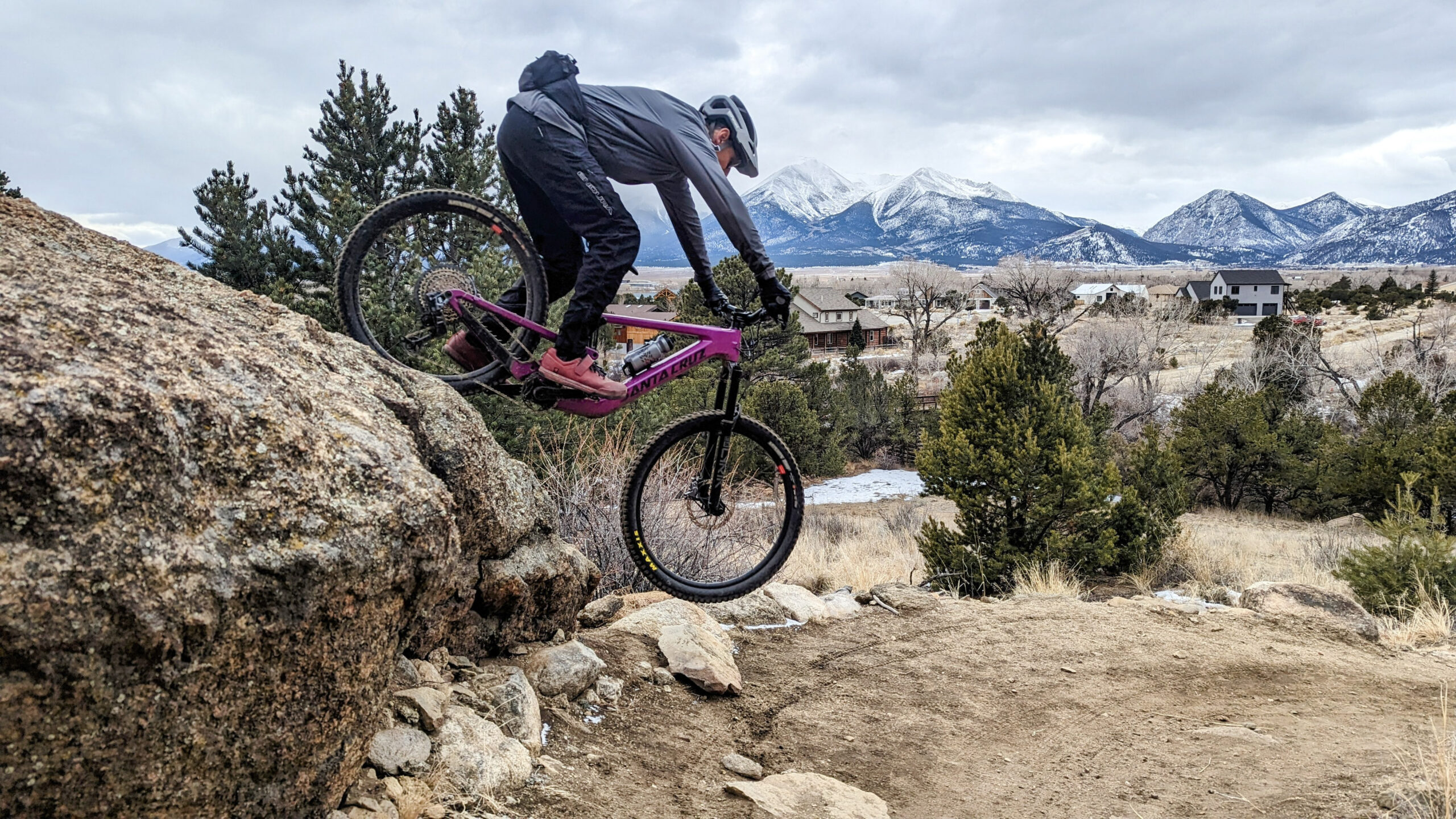
Santa Cruz’s take on this lighter eMTB category pairs a very familiar-looking frame design with the Fazua Ride 60 drive system. Most of my initial questions about the Heckler SL revolved around the drive system’s capability and range. Lots of long rides in varied terrain have answered these questions and more.
Fit & Sizing
Simon Stewart (6’, 170 lbs / 183 cm, 77 kg): I stated in my initial Flash Review of the Heckler SL that the fit was about as good as it gets for me, and after hundreds of miles, that sentiment has not changed. This doesn’t come as a surprise since I have always found Santa Cruz bikes in a size Large to fit me extremely well.
The Heckler SL did not require a single part to be exchanged to dial in the fit for my preferences. With that said, the 635 mm stack height (size Large, low position) is a tiny bit lower than I like for eMTBs (I go into detail about my thoughts on eMTB stack height in our Pivot Shuttle LT review). For comparison, the Pivot Shuttle AM has a stack height of 651 mm (size Large, low position), and I find this to be roughly my ideal height.
Fortunately, the Heckler SL shipped with plenty of steerer tube length to add spacers under the stem to get the bars where I like them. Because the 477.5 mm reach (size Large, low position) is on the longer side of my preferred range (470 to 480 mm), I didn’t need to resort to a higher–rise handlebar to get there. The longer reach makes me less protective of raising the stem, which can have the adverse effect of shortening the reach.
One other note on sizing: the Heckler SL has the size range (XL and XXL) to accommodate pretty tall riders, but anyone under 5’1”-ish (~155 cm) is most likely out of luck since Santa Cruz does not offer it in an XS size. Santa Cruz is not alone in this department, and XS full-suspension eMTBs are not very common industry-wide. This undoubtedly has more to do with battery size and the available downtube real estate in the XS sizes than anything else, so it’s hardly a Santa-Cruz-specific limitation. I’m hopeful that, as battery technology continues to advance, more XS eMTBs will become available.
Climbing
An eMTB’s climbing performance comes down to a whole lot more than just raw motor power. It’s a given that the majority of eMTBs are going to climb pretty well. You could strap a motor to a shopping cart and probably do ok. But it’s the bikes where their geometry, suspension, fit, and drive system work in harmony that stand out, and the Heckler SL definitely stands out.
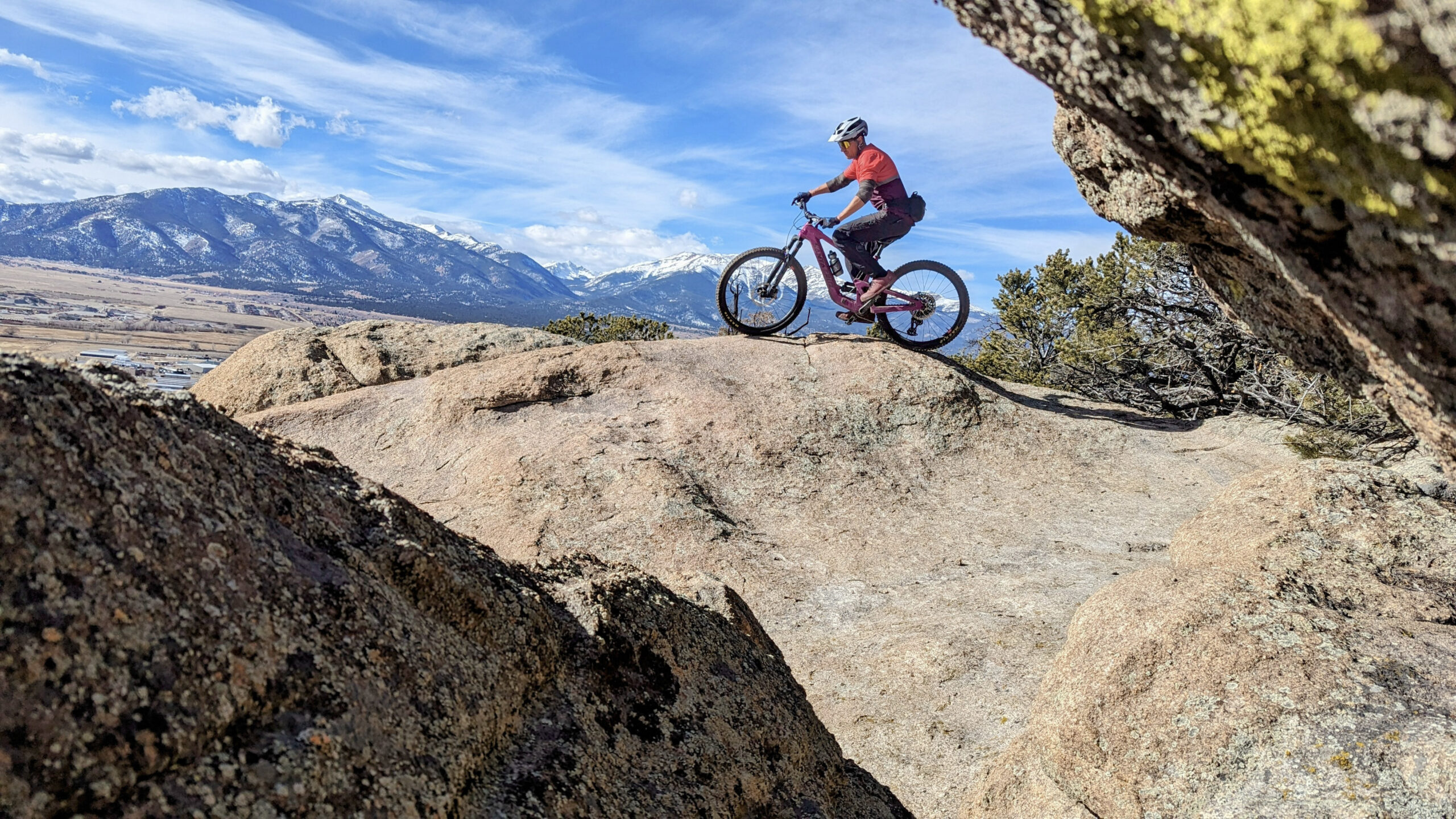
In terms of the Heckler SL’s geometry, its steep 77.2º seat tube angle, not crazy slack 64º head angle, and 478 mm reach (all in the low position) make it a comfortable place to spend time while climbing. When the trail steepens, the Heckler SL requires only slight adjustments in body position to maintain control and it holds its line very well.
This bike’s RockShox Super Deluxe rear shock does a great job of keeping the wheel in contact with the ground and complements the VPP suspension beautifully, providing excellent traction. The motor’s power delivery is never abrupt, and honestly, it just doesn’t have the torque to overcome the rear wheel’s traction (as some full-power eMTBs do). This gives the Heckler SL an overall very composed and controlled demeanor. In contrast, full-power eMTBs can feel frantic and loose when climbing in their highest power settings, which is a bit of an acquired taste, but something I do also enjoy.
An area where the Heckler SL does especially well is climbing up big, squared-off ledges. Its front end comes up easily due to the lighter weight of the battery and motor, and the required forward weight shift feels natural. Ledging up on the Heckler SL feels much closer to a non-powered MTB than it does to a full-power eMTB.
Timing a full-power eMTB’s power-assisted wheelie can be tricky, and while it is a skill I love practicing, it often isn’t the smoothest way up a ledge and can put the motor’s bash guard to the test — the larger motors of full-powered eMTBs have a tendency to reduce clearance under the frame. The tightly packaged motor in the Heckler SL doesn’t have those same clearance issues, and the motor’s smooth power delivery adds to the Heckler SL’s technical climbing ability.
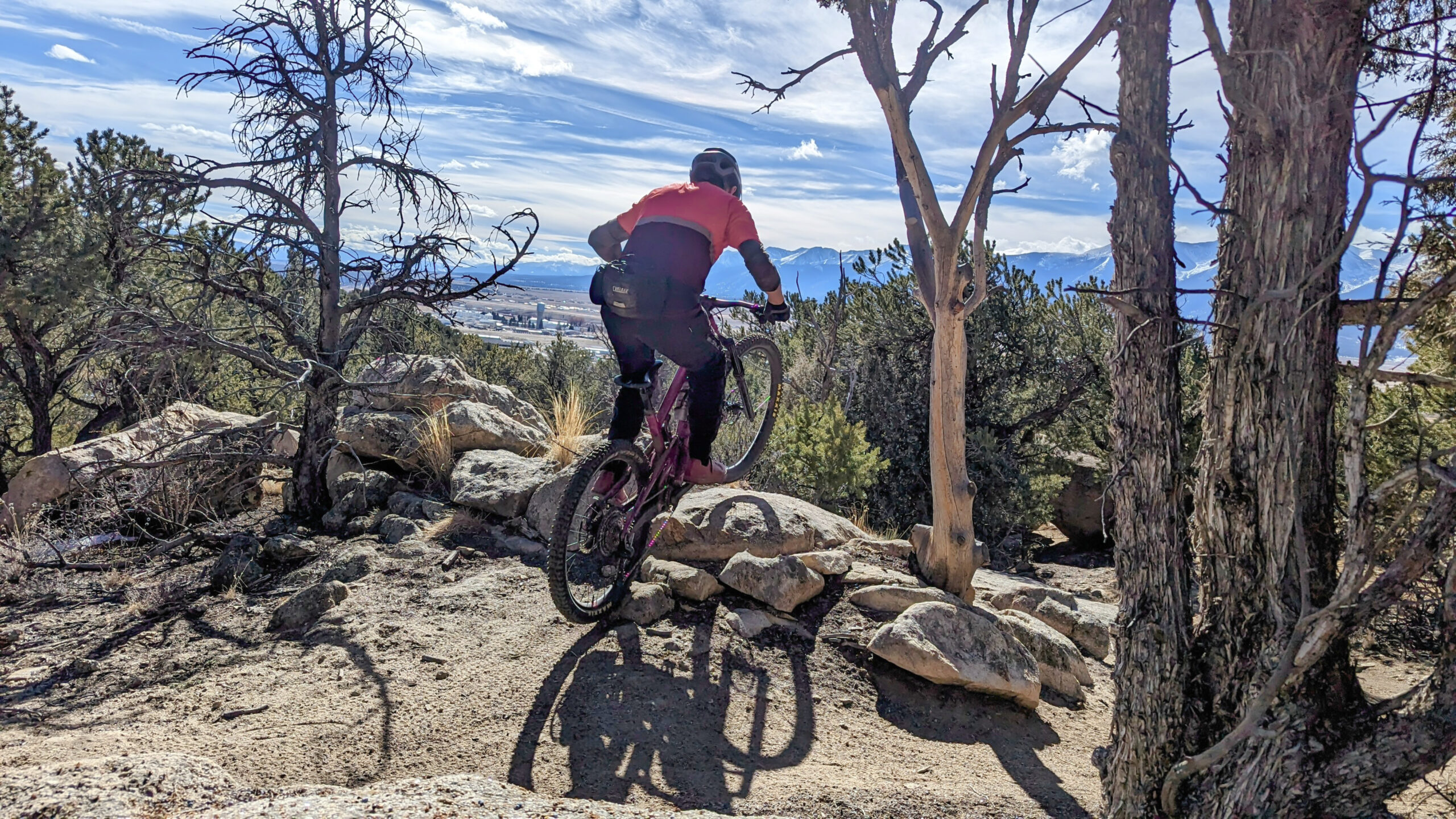
When quantifying the climbing performance of full-power eMTBs I have a handful of trails that have fantastically steep and technical sections that I use as benchmarks. Bikes like the Pivot Shuttle AM, Orbea Wild, and Rocky Mountain Instinct Powerplay have put in some of the best efforts to date, but they are all full-powered eMTBs, and the Heckler SL is not. I wasn’t initially planning on putting the Heckler SL through these same climbing tests. But as I got more comfortable on it, I started playing around on some really steep stuff and was getting surprisingly good results.
While the Heckler SL did not best any of the high-water marks set by the full-power eMTBs, it wasn’t far off, either. Now, it did take heaps more effort on my part to get it up as high as I did, but I also enjoyed that challenge and it is an element of lower-power eMTBs that I welcome. I also had to have well-timed usage of the Fazua Ride 60’s Boost mode for my best attempts. The Boost mode accesses the motor’s full 450 watts of power, but you only get it for 12 seconds, so timing it to have the extra watts on tap for the crux moves took practice.
So, in the end, it was the Heckler SL’s lower motor output that was the limiting factor. This was a completely expected result — how close the Heckler SL got to the full-power eMTBs, however, was not expected, and a testament to how well sorted it is.
Descending
I like mixed-wheel-size eMTBs — I think they tap into the fun side of riding mountain bikes with motors. The Heckler SL is first and foremost a fun descender, but it is not so focused on fun and playfulness that it sacrifices a bunch of stability and composure to get there.
Its geometry numbers are most definitely current, neither on the conservative side nor category-pushing for an eMTB in this travel range. For me, this gives the Heckler SL a familiar and easy-to-get-along-with personality, one that builds confidence and inspires an aggressive riding style. But the beauty of what Santa Cruz has accomplished with the Heckler SL is that it is equally as good when ridden with a dialed-back, less aggressive approach.
The Heckler SL has flip chips that offer a high and low bottom bracket position, with each setting having a small effect on other geometry numbers as well. I tried it in both settings and ultimately landed on the Low setting as my preference. It’s not a big difference overall but it does feel a touch more athletic when cornering and a slight bit more playful when descending.
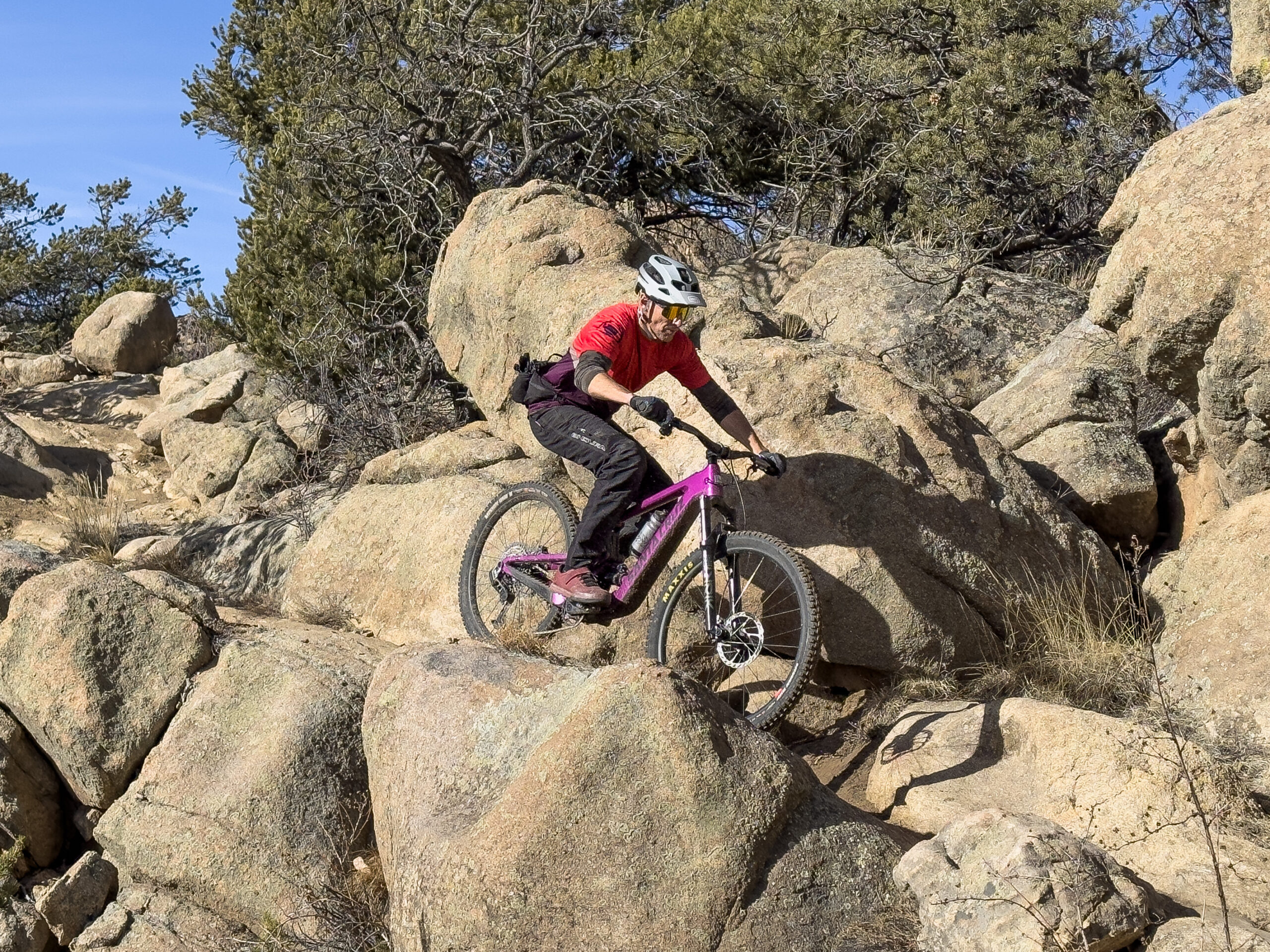
The RockShox Lyrik Select+ and RockShox Super Deluxe Select+ on our test bike are well-matched and provide a nice, balanced ride with great small-bump sensitivity. I’ve previously mentioned the hydraulic bottom-out feature in the Super Deluxe Select+ being a real asset, and the more I rode it, the more it impressed me — the Heckler SL took some big impacts and drops with little to no drama. The travel indicator o-ring (“fun-o-meter” in RockShox speak) was always at the bottom of the shock body after rides, proving all the travel was utilized, yet I still never experienced any harsh bottom-outs.
The lower weight of the Heckler SL is most noticeable when getting the bike off the ground. Bunny hopping heavy, full-powered eMTBs is not easy, and I often feel it most in my knees. I’m not alone here either, as friends of mine who ride full-power eMTBs have complained about this, too. We have even coined the term “e-knee” for it, which is knee pain we think comes from bunny-hopping, manual-ing, and landing drops on 50+ pound eMTBs. Fortunately, I didn’t experience “e-knee” on the Heckler SL — it is significantly easier to get off the ground, feels nicely balanced while in the air, and lands with less energy and force transmitted up through my feet.
I mentioned above that the Heckler SL’s geometry numbers are neither aggressive nor conservative, and that makes the Heckler SL a versatile descender. It is not such a speed-hungry machine as the Orbea Wild and has more in common with the well-rounded nature of the Pivot Shuttle AM. I was going to say that, overall, the Heckler SL is more maneuverable when descending than the full-power eMTBs I’ve tested, but that’s not entirely true — I think it is more accurate to say that it requires less effort to maneuver. The Heckler SL does feel lighter on its feet and prefers a bit more attention be paid to line choice than, say, the Pivot Shuttle AM, but that’s also why it comes across as a touch more playful.
The Build
I’m a fan of Santa Cruz’s SRAM-focused builds. I like SRAM’s wireless shifting, RockShox suspension, Code brakes, and the tidy integration of the handlebar controls that tie it all together.
The Heckler SL GX AXS I’ve been riding is the first bike I’ve had in for review with SRAM’s GX Eagle Transmission. I think, in general, eMTBs are a good test of a drivetrain since I definitely shift more often under load while riding them, and the loads are usually higher than non-powered bikes. Also, my eMTB rides typically cover more miles, which equates to more shifts per ride. Compared to the XO Eagle Transmission on the Pivot Shuttle AM that we also have in for review, I honestly find the shifting performance indistinguishable between the two Transmissions. If given two identical bikes to ride, one with XO Eagle Transmission and the other with GX, while not being allowed to look at the drivetrain beforehand, I’m pretty certain I wouldn’t be able to tell which one had what.
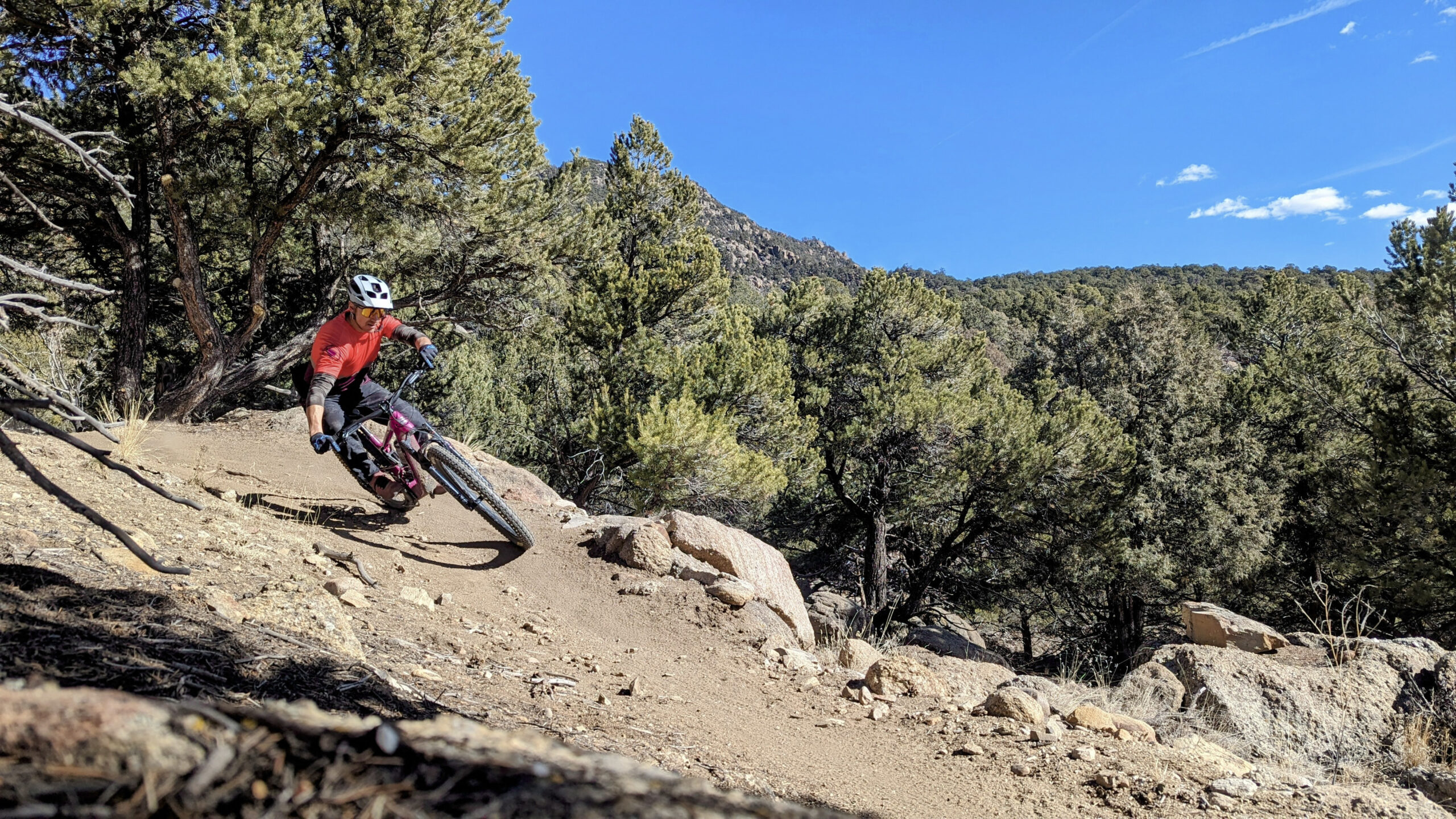
I have read many negative comments about the slow shift speed of SRAM’s AXS Eagle Transmission drivetrains. They indeed shift a bit slower than the previous-generation AXS, but in my experience, the slower speeds improve accuracy and shifting performance under load. I’ll take this small compromise since shifting performance under load is why the AXS Transmissions are my preferred drivetrains for eMTBs. We dig into the SRAM GX Eagle Transmission in more detail in our First Look here, and have some more on-trail impressions in our Flash Review here.
The GX AXS build comes with Reserve 30 SL aluminum rims laced to DT Swiss 370 hubs. The 370 rear hub utilizes DT Swiss’s Star Ratchet freehub technology, and with 36 tooth ratchets, that translates to 10º of engagement. On eMTBs especially, where there is more strain on the rear hub, I appreciate the piece of mind I get from knowing there is a bomber DT Swiss Star Ratchet freehub managing those additional stresses.
Throughout the review, which included many hundreds of miles on rocky trails, the wheels didn’t require any truing, and spoke tension remained constant. The wheels also come with Reserve Fillmore valves; this was my first experience with them and I have to say they do a nice job of the simple task of putting air in and letting it out. I did swap out the rear tire and was able to get the tire to bead with a floor pump — this would have required the removal of the valve core had it been a standard Presta valve (Fillmore valves do not have removable valve cores). The valves also remained clog-free, and when it was time to add sealant, it was super easy to push sealant through the valve with a syringe.
The SRAM Code Bronze Stealth brakes, besides having too long a name, feel great. I think the power and modulation are similar to previous Code brakes but the lever has a more solid and substantial feel to it. The Stealth hose routing looks good, too, with the hose tucked neatly into the handlebar.
I’m a big fan of Santa Cruz’s decision to spec the OneUp V2 seat post. The OneUp dropper post has been one of my favorites ever since it hit the market. I ended up riding the Heckler SL in a wide range of temperatures, including some below freezing. The OneUp post didn’t get sticky or weird once, and this experience cemented my opinion that it is still one of the best out there.
Finally, the Heckler SL in the Gloss Magenta color is a strikingly handsome bike. I have received more positive comments on how awesome it looks than any bike I’ve been on in recent memory.
Drive System and Range
The Fazua Ride 60 drive system was impressive throughout the test period and is a big factor in how much I enjoyed the Heckler SL.
The integration of the drive system is discreet, with the subtle top tube display and a slightly oversized downtube being the only signs that the Heckler SL is hiding a motor. While I don’t have eMTB access issues where I live, I do sometimes have education issues where other trail users are not aware of the legality of eMTBs, and for this reason, I appreciate the Heckler SL’s understated looks and ability to fly under the radar.
I never completely ran the Heckler SL out of power. My longest ride was 38 miles, with about four hours of ride time, and over 4,200 ft of climbing. This was only possible with a lot of attention paid to battery management, and a good portion of the ride was spent in Breeze mode, the lowest level of assist. I used the Ring Controller to toggle up to the full-power Rocket mode on corner exits to get back up to speed quickly, and also on technical climbs. At the end of the ride, the Fazua App showed 6% battery charge remaining. When not going for maximum range and riding solely in Rocket mode, I typically see a little over two hours of ride time. Since I didn’t actually run it out of power, I did deliberately ride the Heckler SL with the motor switched off, and Fazua’s claim of having no mechanical resistance held up. The only other eMTB that I found to pedal as well unpowered is the Trek Fuel Exe with its TQ drive system.
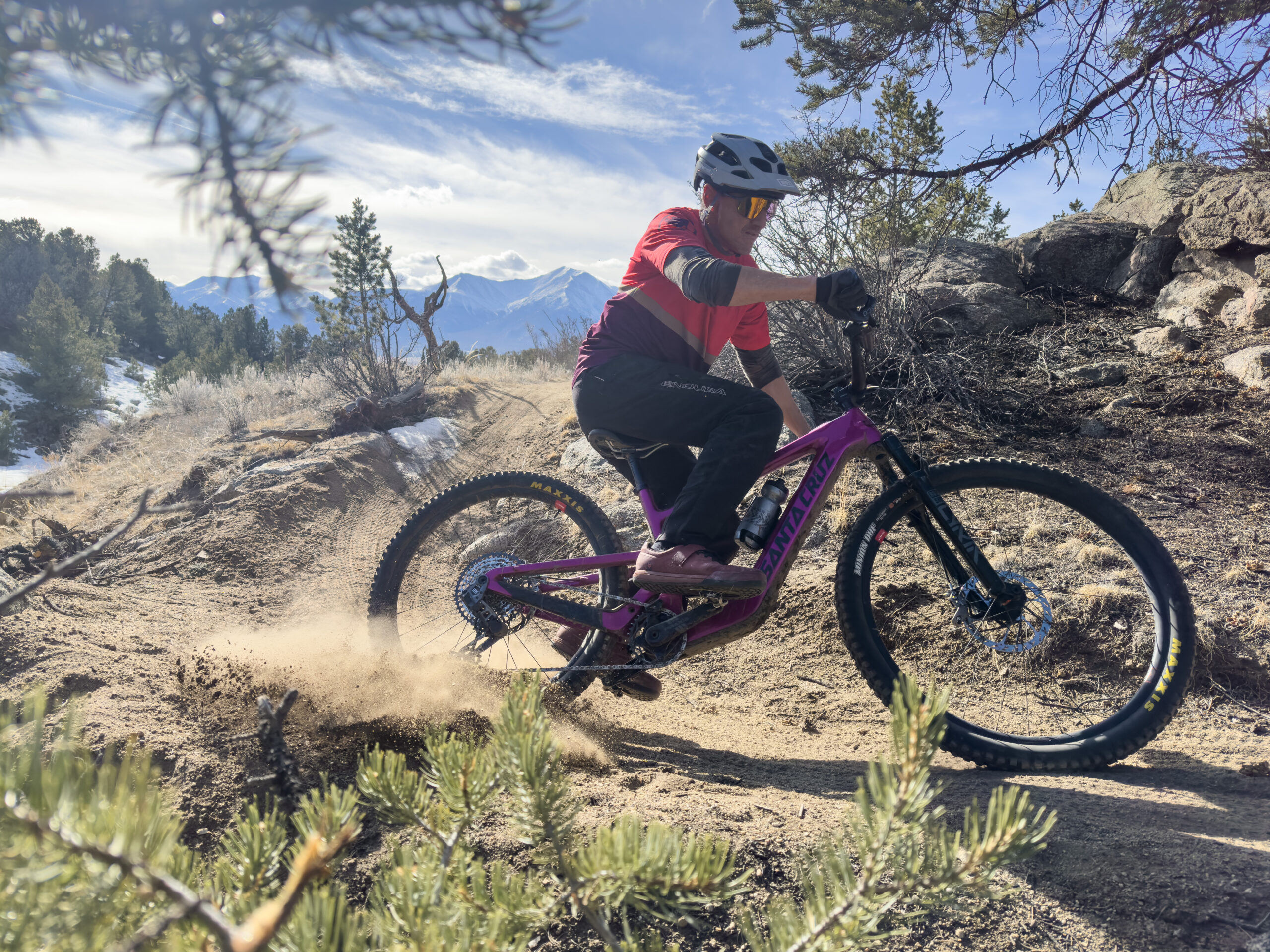
The only issue I had with the drive system was that, occasionally, the Ring Controller took a few attempts to change the assist mode. Since I ride predominantly in full-power mode and toggling into Boost mode requires you to press and hold the Ring Controller for at least two seconds, it didn’t really cause any problems.
I find the Fazua integrated top tube display, which they refer to as the LED Hub, to have mostly adequate information (assist mode and battery level). That said, I prefer the more full-featured top tube displays, such as the Specialized Mastermind TCU or the Rocky Mountain Jumbotron. The Fazua LED Hub has more in common with the Bosch System Controller since it also uses five LEDs to communicate battery charge. However, the Bosch LEDs change color to narrow the battery charge percentage to within 10%. The Fazua LEDs do not (they change color to show different assist modes), so the closest you get to the actual battery charge with the LED Hub is within 20%.
The Fazua App connects via Bluetooth and offers a more detailed picture of what’s going on with the drive system, as well as assist-mode customization options. Much like the Bosch eBike Flow App, the Fazua App can turn your smartphone into a handlebar-mounted display, providing real-time data like speed, distance, and actual battery charge percentage.
I’d rather not take my phone out on rides or have it mounted to my handlebars, so while I generally like the minimalist approach of the LED Hub, having the battery charge only accurate to within 20% means that, on longer rides where battery management is key, taking my phone out is unavoidable. With that said, a nice feature of the Fazua LED Hub is that it pivots up to reveal a USB-C charging port, so at least I can keep my phone charged and use the Fazua App to check the actual battery charge percentage.
Heckler SL vs. Full-Power eMTBs
I was curious how compatible the Heckler SL would be when riding with other folks who are on full-power eMTBs, so I enlisted the help of some friends to do just that. And because I like to ride eMTBs on their highest power setting while also pushing hard myself, I asked my friends to ride the same way. I also chose friends who had similar fitness levels. When riding this way on the lower-powered Heckler SL, it’s really hard — actually, it’s impossible — to keep up with full-power eMTBs, especially on the climbs. If my friends dropped down a couple of assist modes and turned it into a more casual ride then the bikes were much more compatible.
On steep descents, the difference has more to do with geometry and suspension travel than motor power. Descending low-angle trails, motor power does come into play and full-power eMTBs accelerate quicker and keep pulling away from the Heckler SL up to the 20 mph motor cut-off point — but on full-power eMTBs, there is a finality to that cut-off point, and turning yourself inside out for a couple of extra miles per hour just isn’t worth it.
The Heckler SL, on the other hand, encourages you to push past the cut-off, and with a noticeable lack of mechanical resistance, it genuinely rewards the effort with more speed. It easily catches and passes the full-powered eMTBs in a fun game of cat and mouse, that is until the trail either flattens out or starts climbing again.
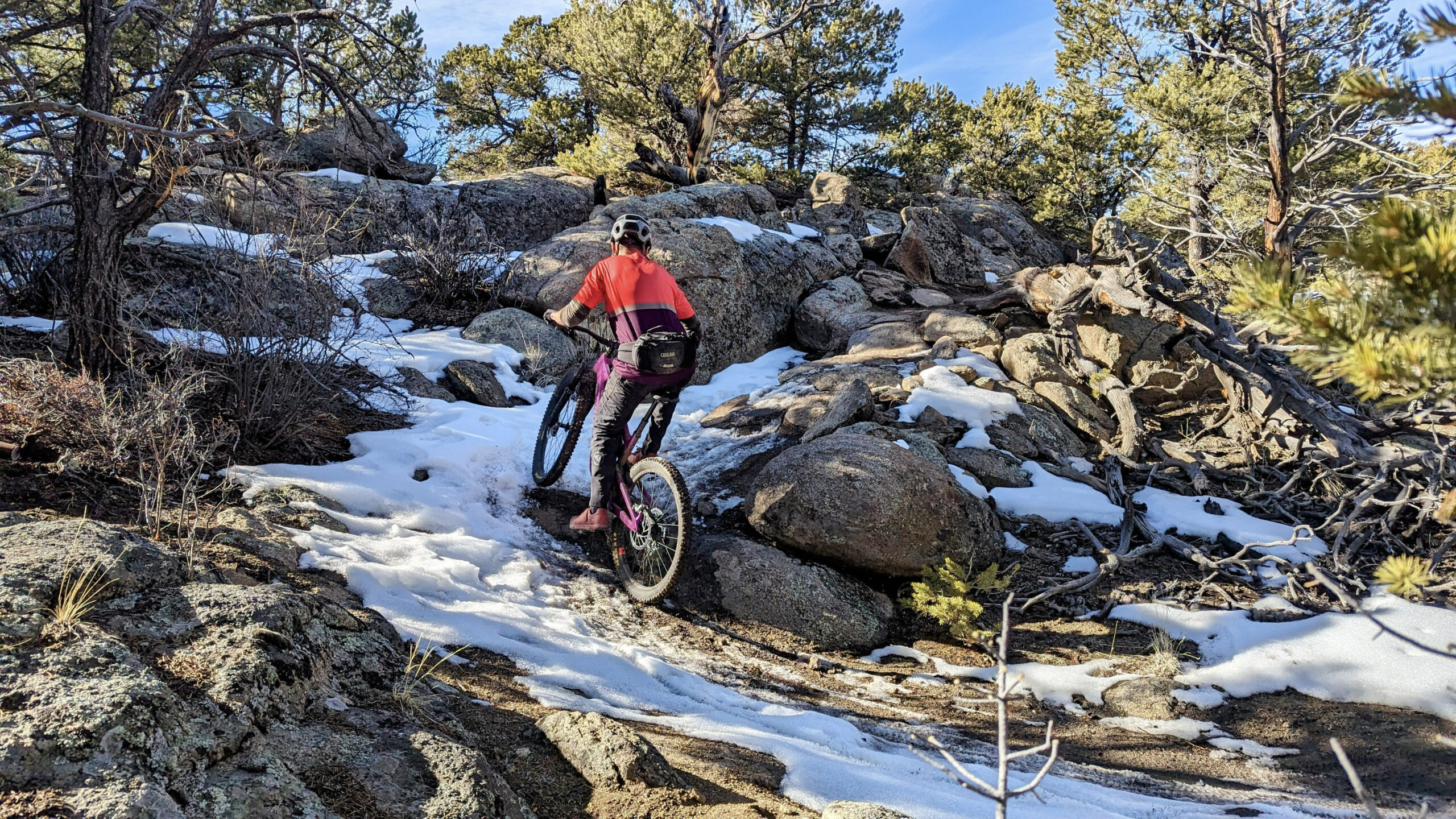
As far as range compatibility goes, there are so many variables that affect range it’s hard to say. I did a pretty unscientific comparison using the Heckler SL vs. a full-power eMTB with a 630 Wh battery, on the same trails, with both in their highest power mode. I found the ride time to be about the same (a little over 2 hours), but the full-power eMTB went further.
Of course, you can casually ride a lower-power eMTB with a friend on a full-power one, but only if the rider on the full-power eMTB chooses a lower-power mode. I don’t like to ride this way myself, and my eMTB rides are nearly always in the highest power mode because going fast is so damn much fun. And since some of my favorite things about eMTBs are riding trails fast with friends, and seeking out ridiculously hard climbs, I think it’s just more fun if everyone is on similarly powered eMTBs.
Who’s It For?
I think the Heckler SL has wide appeal. Riders looking for an attractive, well-made, lightweight eMTB should have it on their shortlist. Folks who aren’t ready for a heavy, full-power eMTB may find the Heckler SL to be a great option to test the eMTB waters. Riders who like to stay fit and enjoy pedaling hard, but want the experience of amplifying their power with a motor, are also great candidates for the Heckler SL. But be advised, if you are planning on riding with friends on full-power eMTBs, I don’t find them to be all that compatible in most cases.
Bottom Line
The Santa Cruz Heckler SL joins a growing category of lightweight lower-power eMTbs, and it surprised me how much I like it. I’ve ridden my fair share of recent Santa Cruz bikes, including the Tallboy, 5010, Hightower, and Bronson, and can say that Santa Cruz has done a masterful job of instilling a little of each of those bike’s DNA into the Heckler SL. It is a cohesive take on a lightweight, lower-power eMTB that also just happens to be incredibly fun to ride.
I teased at the beginning of this review that I would reveal whether the Heckler SL has changed my opinion on my one-bike eMTB quiver, and the answer to that isn’t straightforward. Do I always want a lightweight eMTB in my garage? Yes. Am I willing to have it be my only eMTB? I don’t think so. I guess I’m saying I need more than one eMTB in my life. Either way, the Heckler SL still lands at the top of my list of favorite eMTBs and has been one of the hardest ones to box up and send back. I miss it, a lot.
Deep Dive Comparisons
BLISTER+ members and those who purchase our Digital Access Pass can check out our Deep Dive comparisons linked below. Get our Digital Access Pass to view all our Deep Dives and Flash Reviews, or become a BLISTER+ member today to get access to that and a LOT more, including the best worldwide Outdoor Injury Insurance, exclusive deals and discounts on skis, personalized gear recommendations from us, and much more.
Check out our Deep Dive comparisons of the Santa Cuz Heckler SL to see how it compares to the Trek Fuel EXe, Pivot Shuttle AM, Specialized Turbo Levo, and Rocky Mountain Instinct Powerplay.

